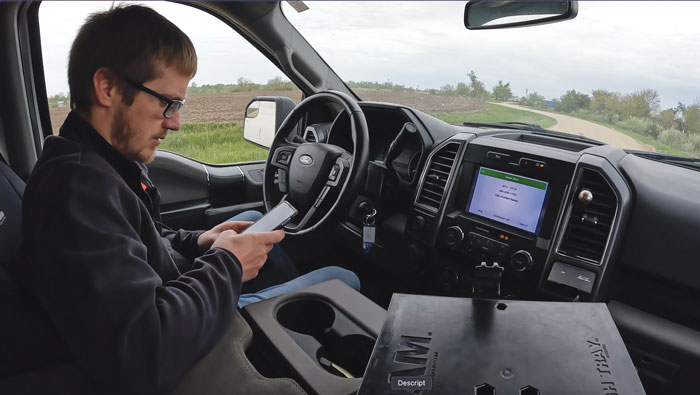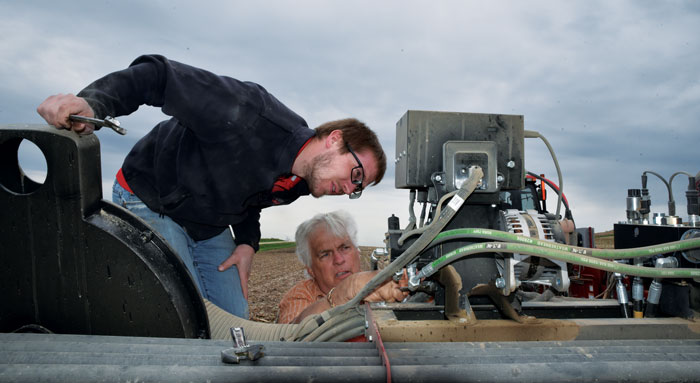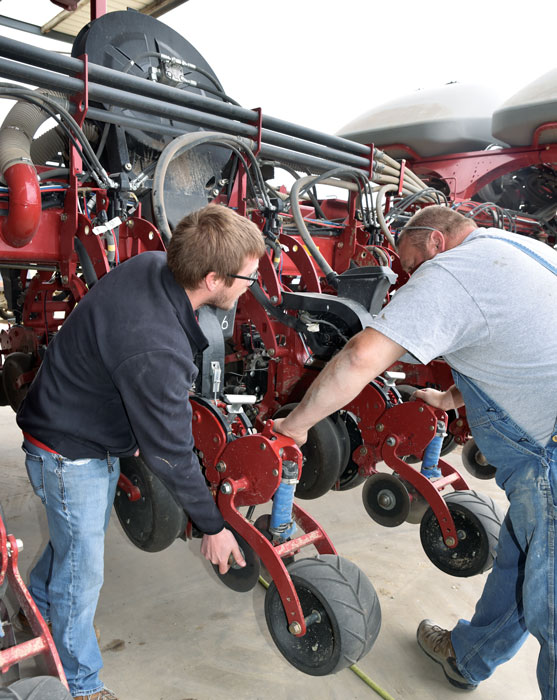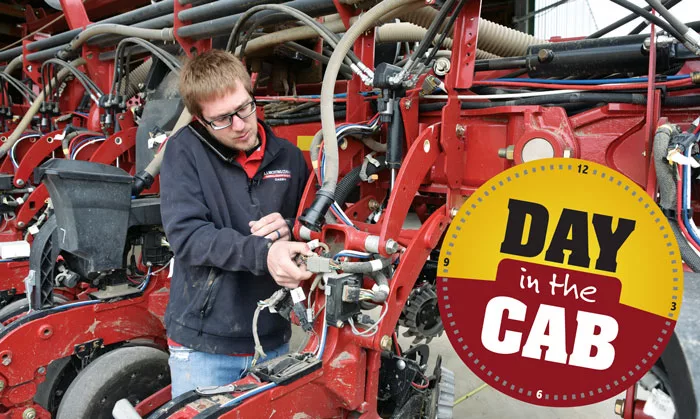Early on in my Day in the Cab visit with Pete Kopriva, precision farming specialist at Case IH dealer J.J. Nichting, he said the amount of phone calls he was getting had “really died down” since the previous week. Planting was well underway in the West Liberty, Iowa, area, and farmers had their monitors figured out by this point.
But a “slow” in-season day for Pete still results in a massive amount of calls, as I’d come to find out during my day with him in mid-May. I lost track of the exact number of calls he received and returned, but it was easily dozens.
At one point, I asked Pete how he keeps up with all of the calls. He says he always calls everyone back, but in the 10 years since he first started working as a precision specialist, he’s learned to put less pressure on himself about his response time with limited hours in the day.
“When there’s a high volume of calls, I try not to let it get to me,” Pete says. “I’m human, too, so if I need to take a break, I do, and I don’t let it bother me.”
Now as one of 3 precision farming specialists at J.J. Nichting’s 5 Iowa stores, Pete teaches customers and coworkers the ins and outs of precision farming with his commitment to customer service.
8:11 a.m.
Although Pete and I agreed to meet at 8:30 this morning, I arrive at J.J. Nichting’s new dealership in West Liberty ahead of schedule to talk to some of the service technicians. Jeremy Marston, the dealership’s chief operating officer, greets me near the parts counter, and we walk back to the shop. The techs agreed to star in a recruitment video for J.J. Nichting, although most are less than thrilled to be on camera at this hour of the day.
The video shoot turns out to be a great way to set the stage for my visit with Pete. The techs note how the team at J.J. Nichting is always willing to answer questions when someone is stuck, and as I’ll come to find out, that’s exactly what Pete will do for much of the day to come.
8:35 a.m.
I walk up to Pete’s office, which is on the second floor of the store in a space the dealership also uses for luncheons and other events. He’s on his computer checking emails, and within a couple of minutes, his phone rings. It’s a customer who’s looking for a harness with Anderson connectors. Pete doesn’t have the connectors, but he has a custom-built harness that could be cut up to take their place. Pete says he’ll leave what he has at the store’s parts counter if the customer decides he wants to give it a try.
8:36 a.m.
About 30 seconds after the call ends, Pete’s phone rings again. It’s another customer, Ryan, who farms nearly 5,000 acres in the West Liberty area. He’s asking Pete about a harness to get a downforce sensor on his Case IH 2150 Early Riser planter working again. Pete says he’ll get the parts and head over to his farm. After he hangs up the phone, grabs the harness for the first customer and packs up his computer, we head downstairs to collect the parts Ryan needs.
J.J. Nichting invested in one consolidated parts area when the dealership built the new West Liberty store in 2021. Prior to that, the parts were stored among 3 locations. The new layout makes it a lot more efficient for Pete, other staff and customers to get the parts they need.
It also helps store the big stock orders the dealership has been placing to mitigate widespread inventory issues. Pete says he’s been targeting customers based on what he has available, even if it might not be exactly what the customer originally wanted.
“We’re trying to show them we still have availability of other products and stuff they can invest their money in,” Pete says. “We’ve had a pretty decent response from customers.”
8:44 a.m.
As Pete is gathering parts and talking with his coworkers about what parts he’s taking and who needs them, his phone rings several more times. Pete takes the calls as he receives them, continuing to pick up parts and pack up his service truck. We hit the road about 15 minutes later.

A decommissioned WASS satellite resulted in dozens of calls to Pete Kopriva. Here he pulls over on a side road to email another J.J. Nichting precision farming specialist a flowsheet with step-by-step instructions to switch the satellites.
9:16 a.m.
Around this time, a call comes in from a customer who discovered a 4-foot overlap in one direction while planting and a 4-foot gap the other way. After talking through it, Pete discovers the customer switched monitors and didn’t check his row shutoffs before planting.
“It’s not the phone call I like to hear because we should have checked it before planting,” Pete says after he hangs up.
J.J. Nichting offers support packages for farmers that are tailored to the customer’s needs. Services range from preseason monitor cleanup to in-season support to postseason data management. Pricing depends on how much help the customer wants and needs.
“Some years you win, some years you lose,” Pete says, “but at the end of the day, it makes the customer more loyal. If they want this type of support, they’re going to buy their precision stuff from me and hopefully buy their equipment from the dealership.”
9:23 a.m.
As I’m asking Pete more about the service packages, his phone rings. It’s Ryan again, calling to give us his location. After hanging up, Pete starts telling me a little about Ryan’s operation when his phone rings again. It’s one of J.J. Nichting’s technicians, who sounds pretty flustered as he’s asking Pete why warnings are popping up on a Case IH planter monitor that is also running Precision Planting equipment.
Pete spends about 20 minutes talking the tech through the monitor step by step to disable the warnings — without ever looking at anything for reference. He says it took him a couple of months to be able to recall the menus and settings without having the monitor in front of him, but now he has certain monitors memorized.

Wrench in hand, Pete Kopriva attempts to pinpoint the source of an oil leak on the alternator of a customer’s Case IH 36-row Early Riser 1265 planter.
“It’s engraved in my brain,” he says with a laugh. “I have nightmares about it.”
9:54 a.m.
While Pete is walking the tech through what to tap to resolve the issue, his phone is lighting up with more incoming calls. We stop for gas, and Pete starts returning some of those missed calls.
He soon discovers WASS GPS is down, an expected but somewhat challenging problem. WASS satellite 138 was decommissioned, so customers need to switch to WASS 135 instead. Pete tells the first precision specialist who called about it that he’ll send a flowsheet with step-by-step instructions to manually switch to the new satellite. He hangs up and immediately gets a call from another precision specialist about the same issue. Pete says he’ll send the document with the flowsheet and hangs up.
“I have a feeling we’re going to have a lot of phone calls about this today,” Pete says as he emails the flowsheet from his phone.
Pete estimates close to 50% of his customers are using WASS on one or more of their machines. Many use the free GPS on tillage tractors that don’t need high-accuracy positioning.
“At the end of the day, [a support package] makes the customer more loyal…”
We’re still driving, and Pete’s still taking calls. He’s gotten some more calls about problems resulting from the decommissioned satellite and talked to a customer with a sprayer that keeps shutting off. He also answers a call from a man named Cowboy who’s having issues with his path getting wider every time he goes around a curve. Pete spends about 15 minutes walking him through potential fixes on his monitor.
10:12 a.m.
As we pull up to the farm shop, we see Ryan and the planter. We say hello and learn one of Ryan’s guys has a tractor down with a very familiar GPS issue. The decommissioned satellite strikes again, but by now, Pete knows how to solve it. Ryan hands Pete his phone, and Pete talks the guy through changing to the new satellite.
As he’s talking, Pete starts inspecting Ryan’s planter and unfastening some of the cables connected to the downforce sensors on rows 6 and 8. He makes better progress after hanging up the phone, and he continues working on the planter for the next hour and a half. Pete shows Ryan how to reset the downforce sensors from the monitor in the tractor, and everything appears to be working correctly.
11:43 a.m.
We leave Ryan to a busy day of planting and set out to meet Mark, a customer who called earlier about the WASS issue.
12:07 p.m.
We come up over a hill and see a Case IH Magnum 340 with a 36-row Early Riser 1265 planter parked in the field. Mark, the farmer and planter’s owner, is waiting inside the tractor cab. Since Pete was in the area, he told Mark he’d stop by and reconfigure the WASS GPS for him. Pete climbs into the cab and makes the switch in a matter of minutes.
Mark also mentions an oil leak on the planter’s alternator, so Pete attempts to tighten the hose with a wrench. The leak is nearly nonexistent when Mark turns on the planter. Pete tells Mark it should be fine to continue planting, and he’ll go over it again after planting season is over.
12:19 p.m.
We say goodbye to Mark and hit the road again. Pete starts catching up on missed calls, including another from Cowboy, whose problems continue today. Cowboy says his planter is now 5 feet off when he goes around curves, a problem that Pete isn’t familiar with and isn’t able to fix over the phone. Pete says he’ll look into it when he gets back to the dealership and will call Cowboy back.

Pete Kopriva and Ryan, a customer who farms nearly 5,000 acres in the West Liberty, Iowa, area, take a closer look at row unit 6, which had a downforce issue caused by a broken wire.
12:39 p.m.
We stop for lunch at Subway in Tipton, and Pete takes a well-deserved break from answering his phone. However, it’s not much of a break from answering questions because he’s sharing a table with me. I ask Pete if customers are billed for his time on the phone. He says no, but they should be because on days like today, he could spend all day at his desk fixing issues over the phone.
“Customers expect to pay for service if somebody has to go out there, but if I could fix it over the phone, you get the same result and don’t waste time waiting for someone,” Pete says.
However, he understands the barrier to asking someone who’s just spent hundreds of thousands of dollars on equipment to purchase a service plan. He theorizes making a plan that would automatically enroll someone in a service package if they spend a certain amount of money with the dealership every year, and we continue to talk about billing as we finish up our lunch.
1:04 p.m.
Back in the truck, Pete returns more phone calls before heading back to the dealership. He says the dealership considered posting something to Facebook about the WASS satellite changeover prior to today, but they never did. He thinks it could have been helpful, although actually changing the settings is advanced for most of his customers.
Check Out the Day In the Cab Video
Pete Kopriva, precision farming specialist at Iowa Case IH dealer J.J. Nichting, expands on the precision sales and service strategies in place at J.J. Nichting in exclusive video filmed during Precision Farming Dealer’s Day in the Cab. visit www.PrecisionFarmingDealer.com/ditc.
The latest installment of the Day in the Cab series is brought to you by SWAT MAPS.
Pete and J.J. Nichting’s other precision specialists have been making an effort to increase the precision knowledge of both customers and other dealership staff. They’ve held customer clinics in the past and did a day-long training program for the technicians at each of the dealership’s stores. The technician course went through some of the most common questions about the Case IH and Precision Planting products carried by the dealership and included a test at the end.
“It’s been working well so far,” Pete says. “Customers have been getting faster support and overall more uptime. It also prevents me from being spread too thin.”
1:31 p.m.
By this time, we’re back at the West Liberty store. Pete’s unloading the truck and — as you may have guessed — taking more phone calls.
Up in his office, Pete gets a call from a customer asking about new planters. The customer wants to talk with Pete, rather than the salesman, about a Kinze planter. Pete gives him a brief overview of the planter and says there’d be other options if he switches colors. The customer asks Pete to stop by the farm to talk about it more, and Pete says he’ll call him later that day to schedule a time to stop tomorrow.
Pete also has been proactive with sales conversations about planters this year due to long wait times for new equipment. Discussing planter upgrades during or right after planting season helps ensure availability and gives the grower a better perspective on what they want.
“The pain of going through planting with a system that didn’t work for them is fresh in their mind,” Pete says. “If I talk about it in June when the corn’s coming up, there’s a lot more passion behind the conversation for doing something differently.”
2:19 p.m.
The calls continue as Pete and I shoot a couple of videos to accompany this article. You can watch them by scanning the QR code earlier in this article.
3:07 p.m.
Once we finish filming, we head back up to Pete’s office, where he plans to be for the rest of the day so he can catch up on phone calls and emails. I tell him I’ll leave him be, as I’m sure he’s sick of my camera and microphone by now.
Of course, Pete’s phone rings as he’s telling me this, and it’s Cowboy again, wondering if Pete has found any answers. Pete starts asking him more questions while he sits down at his computer. I pack up my gear, wave goodbye to Pete and head to my car to catch up on my own emails.







